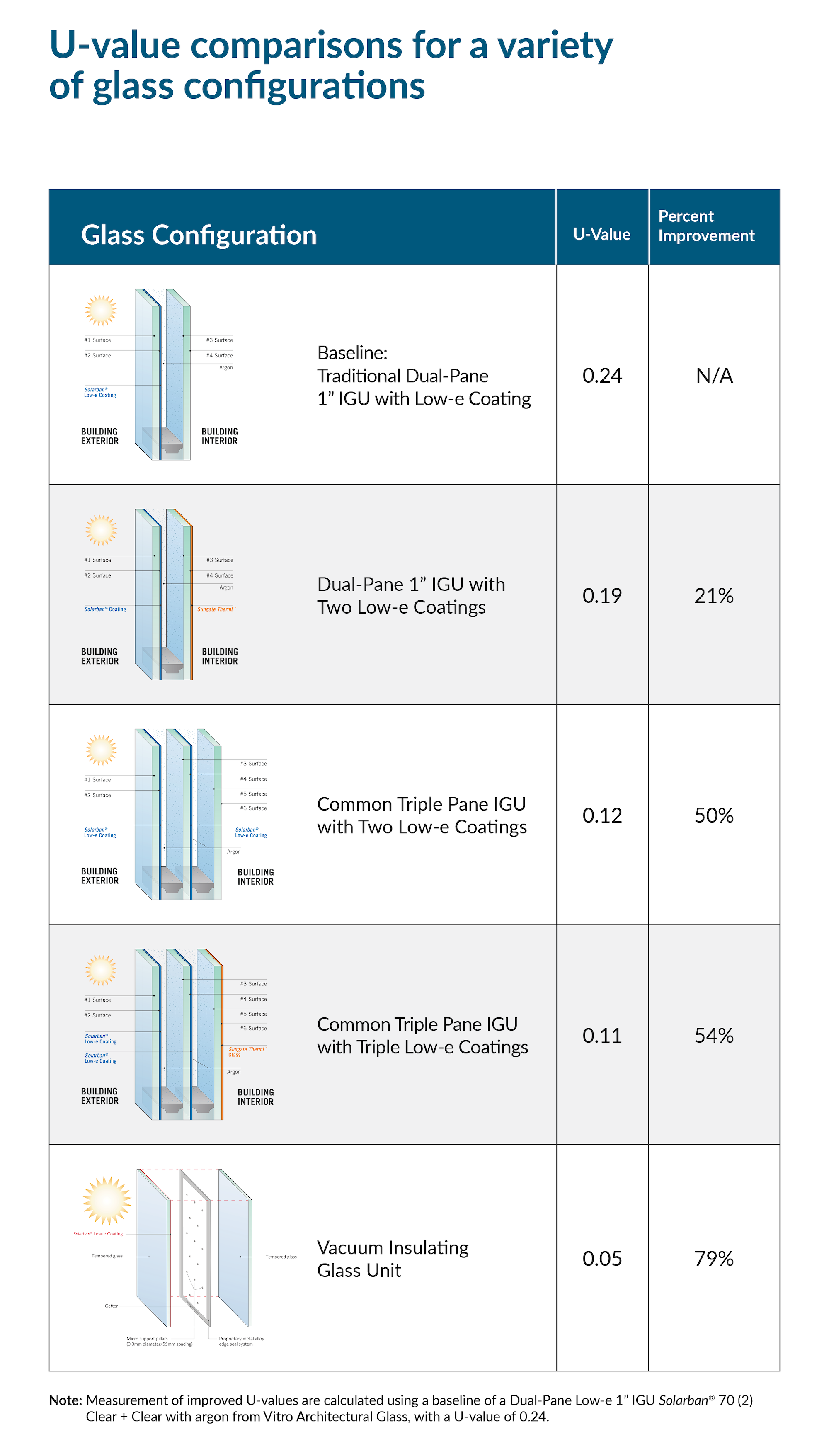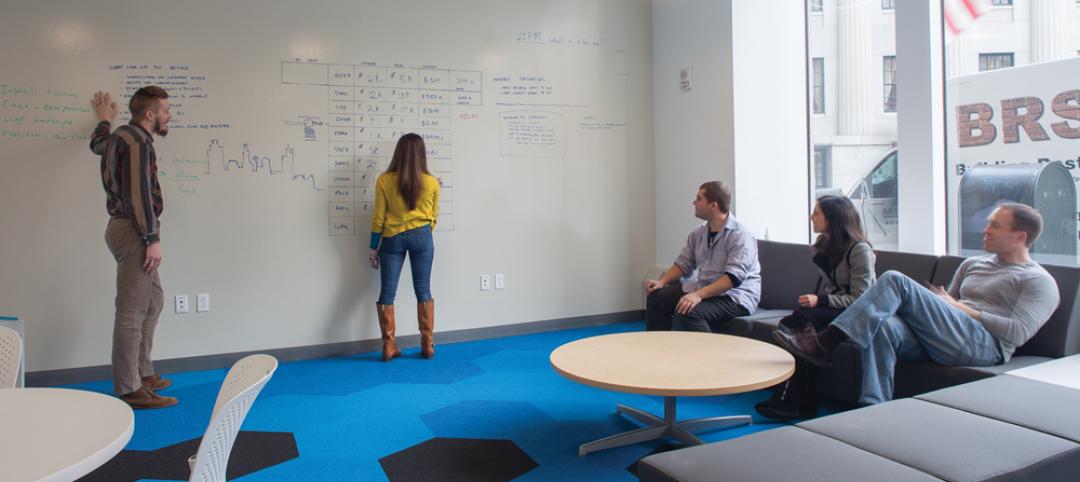The construction and design industries are witnessing a significant shift towards energy-efficient spaces, driven by more stringent building energy codes, increased initiatives and legislation focused on reducing carbon in materials used for building projects and a growing public interest in environmental impact.
While energy efficiency and operational carbon are significant factors in environmentally conscious construction, it’s important to underscore the importance of embodied carbon emissions, which continue to gain traction as a major focus in today’s sustainable design landscape. Architects are increasingly opting for products with low embodied carbon, a term that refers to emissions caused by the manufacturing and installation of construction materials. When assessing the embodied carbon in building products, including glass, the industry standard metric is Global Warming Potential (GWP), measured in kilograms of equivalent carbon dioxide per metric ton (CO2-eq). GWP is used to evaluate the environmental impact of a product's life cycle.
Previously, there was no standard for “low embodied carbon” (LEC) building products; however, there is now. The U.S. Federal Government’s Federal Buy Clean Initiative was established to promote using and developing low-carbon, made-in-America construction materials. In establishing best practices for the U.S. building products industry, standards for LEC products were set by the U.S. General Services Administration (GSA) under the Inflation Reduction Act of 2022 and related guidance from the U.S. Environmental Protection Agency. By these standards, LEC products can fall into three different product categories according to embodied carbon content: Top 20%, Top 40%, and exceeds the industry average.
As the market shifts towards eco-friendly spaces that increase energy efficiency and lower carbon emissions that promote occupant health and well-being, the availability of high-performance architectural glass configurations that significantly boost thermal capabilities and reduce the building's carbon footprint is also on the rise.
Measuring Energy Performance
When assessing the energy efficiency of glass, the U-value, also known as the U-factor, stands out as one of the most critical performance indicators. This metric is a pivotal indicator of the insulating properties of the glass, or in simpler terms, it gauges the amount of heat flow or heat loss that occurs through the glass due to the temperature difference between the interior and exterior. U-values typically span from 0.1 to 1.0. The lower the U-value, the more efficient the insulation. The U-value of a window is determined by the number of British thermal units (Btus) that traverse each square foot of area per degree of temperature difference from one side of the window to the other.
Alongside U-value, R-value is another important metric in thermal performance. U-value is used to measure the performance assemblies of insulating glass units (IGUs), while R-value is used to measure the capabilities of most other parts of the building envelope, such as walls, floors, and roofs. These two values are mathematical reciprocals of each other. Lower U-values indicate better insulating performance, whereas higher R-values indicate better thermal resistance.
More Options than Ever to Enhance U-value
Thanks to the advent of low-emissivity (low-e) coatings and technologies for IGUs, architects now have diverse options to enhance U-values wherever enhanced thermal performance is needed. These cutting-edge choices can enhance thermal potential by two or even three times, leading to substantial annual energy savings and surpassing sustainable design objectives for reducing energy consumption and carbon emissions.
Along with traditional methods to improve U-values, such as using low-e coatings and dual- or triple-pane IGUs with argon gas or warm-edge spacers, new technologies like fourth-surface low-e coatings and vacuum insulating glass (VIG) are transforming the thermal capacity of buildings, offering exceptional improvements in durability and insulation without changing the visual characteristics of the IGU.
Fourth-Surface Low-e Coatings
Fourth-surface low-e coatings are designed to be used on the inside surface of an IGU, and when combined with solar control low-e glass on the second surface, they can significantly improve U-values while still allowing a high rate of visible light transmittance (VLT). These coatings effectively retain indoor temperatures by slowing heat transfer through the IGU. This can help reduce summer cooling costs and winter heating costs, resulting in up to a 20% improvement in the U-value compared to using solar control low-e glass alone on the second surface.
Vacuum Insulating Glass (VIG)
VIG is an innovative high-performance glass that utilizes vacuum technology and a low-e coating in an IGU to provide exceptional thermal capabilities comparable to traditional walls. VIG units typically can be used on their own to replace single-pane glass without replacing the framing system, or they can be used as a substitute for the interior lite in a dual-paned IGU, forming a hybrid IGU. VIG units with a low-e coating can have R-values up to R-20, offering thermal capabilities five times better than conventional insulating glass and up to 20 times better than monolithic glass. They can be incorporated into virtually any traditional glazing system, window frame or curtain wall application.
Advanced Technologies Substantially Improve Thermal Performance
Below is a chart of U-value comparisons for various glass configurations calculated using a baseline of a Dual-Pane Low-e 1” IGU Solarban® 70 (2) Clear + Clear with argon from Vitro Architectural Glass, with a U-value of 0.24. Based on these configurations, the overall thermal performance of a building can be improved by up to 79%. If expressed as R-values, the percentage of improvement would be even more substantial.

Building on the improvements that dual- and triple-pane IGUs have offered for decades, advancements in energy-efficient technologies, such as fourth-surface low-e coatings and VIG, represent the next generation of thermal glazings. These new high-performance IGUs significantly improve thermal insulation capabilities, energy savings and the overall sustainability of the building.
As building code standards demand more energy-efficient products in the future, U-value-optimized IGUs will play a major role in new construction or renovations as they ensure compliance with building energy codes, exceed sustainable design goals and leave a positive environmental impact.
About the Author
Emily Losego is the Director of Commercial Segment Innovation for Vitro Architectural Glass. She works with Vitro’s Marketing & Innovation Team to bring new glass product ideas from the drawing board to the production line. A former practicing architect, national architectural manager and magnetron sputter vacuum deposition (MSVD) product manager for Vitro, Losego is responsible for defining the vision for the architectural commercial market.
Related Stories
| Jul 7, 2014
7 emerging design trends in brick buildings
From wild architectural shapes to unique color blends and pattern arrangements, these projects demonstrate the design possibilities of brick.
| Jul 2, 2014
Emerging trends in commercial flooring
Rectangular tiles, digital graphic applications, the resurgence of terrazzo, and product transparency headline today’s commercial flooring trends.
| Jun 18, 2014
Arup uses 3D printing to fabricate one-of-a-kind structural steel components
The firm's research shows that 3D printing has the potential to reduce costs, cut waste, and slash the carbon footprint of the construction sector.
| Jun 12, 2014
Austrian university develops 'inflatable' concrete dome method
Constructing a concrete dome is a costly process, but this may change soon. A team from the Vienna University of Technology has developed a method that allows concrete domes to form with the use of air and steel cables instead of expensive, timber supporting structures.
| May 29, 2014
Wood advocacy groups release 'lessons learned' report on tall wood buildings
The wood-industry advocacy group reThink Wood has released "Summary Report: Survey of International Tall Wood Buildings," with informatino from 10 mid-rise projects in Europe, Australia, and Canada.
| May 27, 2014
Fire Rated Glass contributes to open lab environment at JSNN
Openness and transparency were high priorities in the design of the Joint School of Nanoscience & Nanoengineering within the Gateway University Research Park in Greensboro, N.C. Because the facility’s nanobioelectronics clean room houses potentially explosive materials, it needed to be able to contain flames, heat, and smoke in the event of a fire. SPONSORED CONTENT
| May 27, 2014
Contractors survey reveals improving construction market
The construction industry is on the road to recovery, according to a new survey by Metal Construction News. Most metrics improved from the previous year’s survey, including a 19.4% increase in the average annual gross contracting sales volume. SPONSORED CONTENT
| May 20, 2014
Kinetic Architecture: New book explores innovations in active façades
The book, co-authored by Arup's Russell Fortmeyer, illustrates the various ways architects, consultants, and engineers approach energy and comfort by manipulating air, water, and light through the layers of passive and active building envelope systems.
| May 20, 2014
Using fire-rated glass in exterior applications
Fire-rated glazing and framing assemblies are just as beneficial on building exteriors as they are on the inside. But knowing how to select the correct fire-rated glass for exterior applications can be confusing. SPONSORED CONTENT
| May 15, 2014
Paints, coatings, and sealants: 10 new ways to seal the deal
Color-shifting finishes, dry-erase surfaces, and stain-blocking paints are highlighted in this round up of new offerings in paints, coatings, sealants, and finishes.

















